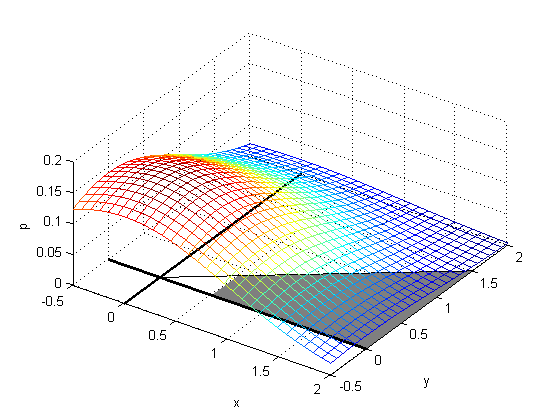
 |
Home | Libraries | People | FAQ | More |
#include <boost/math/special_functions/owens_t.hpp>
namespace boost{ namespace math{ template <class T> calculated-result-type owens_t(T h, T a); template <class T, class Policy> calculated-result-type owens_t(T h, T a, const Policy&); }} // namespaces
Returns the Owens_t function of h and a.
The final Policy argument is optional and can be used to control the behaviour of the function: how it handles errors, what level of precision to use etc. Refer to the policy documentation for more details.

The function owens_t(h, a) gives the probability of the event (X
> h and 0 < Y < a * X), where X and
Y are independent standard normal random variables.
For h and a > 0, T(h,a), gives the volume of an uncorrelated bivariate normal distribution with zero means and unit variances over the area between y = ax and y = 0 and to the right of x = h.
That is the area shaded in the figure below (Owens 1956).
and is also illustrated by a 3D plot.

This function is used in the computation of the Skew
Normal Distribution. It is also used in the computation of bivariate
and multivariate normal distribution probabilities. The return type of this
function is computed using the result
type calculation rules: the result is of type double when T is an integer type, and type T
otherwise.
Owen's original paper (page 1077) provides some additional corner cases.
T(h, 0) = 0
T(0, a) = ½π arctan(a)
T(h, 1) = ½ G(h) [1 - G(h)]
T(h, ∞) = G(|h|)
where G(h) is the univariate normal with zero mean and unit variance integral from -∞ to h.
Over the built-in types and range tested, errors are less than 10 * std::numeric_limits<RealType>::epsilon().
Table 6.83. Error rates for owens_t
|
Microsoft Visual C++ version 12.0 |
GNU C++ version 5.1.0 |
GNU C++ version 5.1.0 |
Sun compiler version 0x5130 |
|
|---|---|---|---|---|
|
Owens T (medium small values) |
Max = 4.37ε (Mean = 0.973ε) |
Max = 0ε (Mean = 0ε) |
Max = 3.34ε (Mean = 0.942ε) |
Max = 3.34ε (Mean = 0.91ε) |
|
Owens T (large and diverse values) |
Max = 3.78ε (Mean = 0.621ε) |
Max = 0ε (Mean = 0ε) |
Max = 49ε (Mean = 2.16ε) |
Max = 24.5ε (Mean = 1.38ε) |
Test data was generated by Patefield and Tandy algorithms T1 and T4, and also the suggested reference routine T7.
atan(a)
(ie cancellation),
Over the built-in types and range tested, errors are less than 10 std::numeric_limits<RealType>::epsilon().
However, that there was a whole domain (large h, small a) where it was not possible to generate any reliable test values (all the methods got rejected for one reason or another).
There are also two sets of sanity tests: spot values are computed using Wolfram Mathematica and The R Project for Statistical Computing.
The function was proposed and evaluated by Donald. B. Owen, Tables for computing bivariate normal probabilities, Ann. Math. Statist., 27, 1075-1090 (1956).
The algorithms of Patefield, M. and Tandy, D. "Fast and accurate Calculation of Owen's T-Function", Journal of Statistical Software, 5 (5), 1 - 25 (2000) are adapted for C++ with arbitrary RealType.
The Patefield-Tandy algorithm provides six methods of evalualution (T1 to T6); the best method is selected according to the values of a and h. See the original paper and the source in owens_t.hpp for details.
The Patefield-Tandy algorithm is accurate to approximately 20 decimal places, so for types with greater precision we use:
Using the above algorithm and a 100-decimal digit type, results accurate to 80 decimal places were obtained in the difficult area where a is close to 1, and greater than 95 decimal places elsewhere.